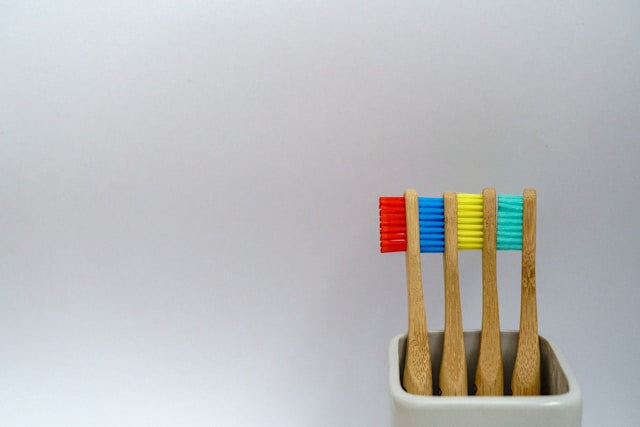When it comes to eco-friendly swaps, the bamboo toothbrush is often crowned the poster child of sustainability. It looks natural, it feels earthy, and it promises a “green” alternative to the neon plastic brushes filling up our landfills.
But here’s the truth you don’t often hear: bamboo toothbrushes aren’t nearly as sustainable as they’re cracked up to be. In fact, once you dig a little deeper, you’ll see that bamboo brushes come with their own set of hidden costs and compromises.
If you’ve ever tossed one into your shopping cart thinking you were doing the planet a favour, here are three reasons to think twice.
1. Bamboo Requires More Resources Than You Think
At first glance, bamboo seems like the ultimate sustainable material. It grows quickly, doesn’t need pesticides, and has a reputation for being “infinitely renewable.” But that’s not the full story.
To turn a raw stalk of bamboo into a toothbrush handle, the plant has to be harvested, transported (often overseas), heat-treated, shaped, sanded, and packaged. Each of these steps consumes natural resources like water and energy—often far more than what’s required for aluminum or even recycled plastic alternatives.
Most bamboo toothbrushes on the market are manufactured in Asia and shipped globally. The carbon footprint of this process undercuts much of the “eco” branding slapped on the packaging. In other words: just because the handle looks rustic doesn’t mean it’s resource-light.
2. Bamboo Toothbrushes Don’t Magically Biodegrade
One of the most common selling points for bamboo toothbrushes is that they “biodegrade.” This paints a nice picture—throw your toothbrush in the garden, and voilà, it vanishes back into the earth.
Reality check: unless bamboo is properly composted in the right industrial setting, it won’t break down quickly. And if you toss it in your regular trash, where it heads straight to the landfill, it will likely sit there for decades, just like plastic.
Landfills are not designed to break materials down; they’re designed to contain waste. They’re oxygen-poor, compacted environments where even food scraps don’t decompose properly. So when a bamboo toothbrush ends up buried under layers of garbage, it doesn’t just disappear. That “biodegradable” claim? It only holds up under very specific conditions that most consumers don’t have access to.
3. The Plastic Problem Still Isn’t Solved
Here’s another piece of fine print: most bamboo toothbrushes still use nylon bristles. That’s right—the part of the brush that actually goes in your mouth is almost always plastic.
The reason is simple: bamboo bristles aren’t durable or hygienic enough to effectively clean teeth. Some brands advertise “plant-based” or “biodegradable” bristles, which are mostly castor bean oil based, and also called 'Nylon 11' due to the amount of processing they require.
The majority, however, are made from nylon-4 or nylon-6, which are petroleum-derived plastics.
This creates two problems:
-
You still have to pluck out the plastic bristles before composting the handle.
-
If you don’t, the entire brush goes to the landfill, where the bristles will stick around indefinitely, and, being so tiny, are culprits in escaping and polluting our waterways and natural environment.
So while bamboo brushes may look greener, they don’t actually solve the root issue of single-use plastic waste.
Why This Matters
The problem with bamboo toothbrushes isn’t that they’re evil or useless—they’re certainly better than disposable plastic brushes in some respects. But their marketing oversimplifies the truth.
We’re at a point where consumers want to make better choices, and brands know it. That’s why so many products are designed to look eco-friendly, even when they only address part of the problem. A bamboo toothbrush handle doesn’t erase the carbon emissions, landfill realities, or plastic bristles still tied up in the design.
This “halfway sustainability” can actually stall progress, because it makes people feel like they’re making a big impact when in reality, the effect is much smaller than promised.
A Better Alternative: Durable, Reusable Materials
If the goal is to create less waste, the solution isn’t swapping one single-use material for another—it’s choosing products designed to last.
That’s why at Nada toothbrush, we created a toothbrush with an aluminum handle and replaceable brush heads. Here’s why this matters:
-
Aluminum is endlessly reusable. Just like your stainless-steel water bottle or cookware, an aluminum handle is built to last for decades. You buy it once, not every few months.
-
Only the small brush head gets replaced and is 100% commercially recycled into other products. Instead of tossing an entire toothbrush, you keep the durable base and swap just the part that wears down. Nada waste.
-
Lightweight and hygienic. Aluminum is naturally resistant to water and bacteria, making it a smarter choice for a product you use every day in your mouth.
It’s a simple idea: instead of repeating the cycle of consumption, you invest in a product designed for permanence.
Final Thoughts
Bamboo toothbrushes might look eco-friendly, but they don’t fully deliver on their promises. They consume natural resources in production, don’t break down easily in landfills, and often still include plastic bristles.
Sustainability isn’t about surface-level swaps—it’s about systems that reduce waste long-term. And that’s why the toothbrush in your bathroom drawer matters more than you think.
So the next time you’re reaching for that “green” bamboo brush at the checkout aisle, ask yourself: is this really solving the problem? Or is it just a prettier version of the same old story?
If you’re ready for a smarter choice, one that’s actually designed to last, Nada is here for you.
👉 Ready to ditch the single-use cycle for good? Discover the Nada Toothbrush today—built to last, designed for the planet.




